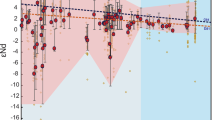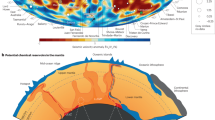Abstract
Modern basalts have seemingly lost all ‘memory’ of the primitive Earth's mantle except for an ambiguous isotopic signal observed in some rare gases1,2. Although the Earth is expected to have reached a thermal steady state within several hundred million years (refs 3, 4) of accretion, it is not known how and when the initial chemical fractionations left over from planetary accretion (and perhaps a stage involving a magma ocean) were overshadowed by fractionations imposed by modern-style geodynamics. Because of the lack of samples older than 4 Gyr, this early dynamic regime of the Earth is poorly understood. Here we compare published Hf–Nd isotope data on supracrustals from Isua, Greenland, with similar data on lunar rocks and the SNC (martian) meteorites, and show that, about 3.8 Gyr ago, the geochemical signature of the Archaean mantle was partly inherited from the initial differentiation of the Earth. The observed features seem to indicate that the planet at that time was still losing a substantial amount of primordial heat. The survival of remnants from an early layering in the modern deep mantle may account for some unexplained seismological, thermal and geochemical characteristics of the Earth as observed today.
This is a preview of subscription content, access via your institution
Access options
Subscribe to this journal
Receive 51 print issues and online access
$199.00 per year
only $3.90 per issue
Buy this article
- Purchase on Springer Link
- Instant access to full article PDF
Prices may be subject to local taxes which are calculated during checkout


Similar content being viewed by others
References
Staudacher, T. & Allègre, C. J. Terrestrial xenology. Earth Planet. Sci. Lett. 60, 389– 406 (1982).
Honda, M., McDougall, I., Patterson, D. B., Doulgeris, A. & Clague, D. A. Possible solar noble-gas component in Hawaiian basalts. Nature 349, 149– 151 (1991).
Schubert, G., Stevenson, D. & Cassen, P. Whole planet cooling and the radiogenic heat source contents of the Earth and the Moon. J. Geophys. Res. 85, 2531–2538 (1980).
Christensen, U. R. Thermal evolution models for the Earth. J. Geophys. Res. 90, 2995–3007 (1985).
Shirey, S. B. & Hanson, G. N. Mantle heterogeneity and crustal recycling in Archean granite-greenstone belts: evidence from Nd isotopes and trace elements in the Rainy Lake area, Superior province, Ontario, Canada. Geochim. Cosmochim. Acta 50, 2631– 2651 (1986).
Chase, C. G. & Patchett, P. J. Stored mafic/ultramafic crust and early Archean mantle depletion. Earth Planet. Sci. Lett. 91, 66–72 (1988).
Galer, S. J. G. & Goldstein, S. L. Early mantle differentiation and its thermal consequences. Geochim. Cosmochim. Acta 55, 227–239 ( 1991).
Harper, J., C. L. & Jacobsen, S. B. Evidence from coupled 147Sm-143Nd and 146Sm-142Nd systematics for very early (4.5-Gyr) differentiation of the Earth's mantle. Nature 360, 728– 732 (1992).
Bennett, V. C., Nutman, A. P. & McCulloch, M. T. Nd isotopic evidence for transient, highly depleted mantle reservoirs in the early history of the Earth. Earth Planet. Sci. Lett. 119, 299–317 (1993).
Vervoort, J. D. & Blichert-Toft, J. Evolution of the depleted mantle: Hf isotope evidence from juvenile rocks through time. Geochim. Cosmochim. Acta 63, 533– 556 (1999).
Rosing, M. T. The theoretical effect of metasomatism on Sm-Nd isotopic systems. Geochim. Cosmochim. Acta 54, 1337– 1341 (1990).
Gruau, G., Rosing, M., Bridgwater, D. & Gill, R. C. O. Resetting of Sm-Nd systematics during metamorphism of >3.7-Ga rocks: implications for isotopic models of early Earth differentiation. Chem. Geol. 133, 225–240 ( 1996).
Vervoort, J. D., Patchett, P. J., Gehrels, G. E. & Nutman, A. P. Constraints on early Earth differentiation from hafnium and neodymium isotopes. Nature 379, 624–627 (1996).
Blichert-Toft, J., Albarède, F., Rosing, M., Frei, R. & Bridgwater, D. The Nd and Hf isotopic evolution of the mantle through the Archean. Results from the Isua supracrustals, West Greenland, and from the Birimian terranes of West Africa. Geochim. Cosmochim. Acta 63, 3901–3914 (1999).
Blichert-Toft, J., Gleason, J. D., Télouk, P. & Albarède, F. The Lu-Hf geochemistry of shergottites and the evolution of the Martian mantle-crust system. Earth Planet. Sci. Lett. 173, 25 –39 (1999).
Nyquist, L. E. & Shih, C.-Y. The isotopic record of lunar volcanism. Geochim. Cosmochim. Acta 56, 2213–2234 (1992).
Unruh, D. M., Stille, P., Patchett, P. J. & Tatsumoto, M. Lu-Hf and Sm-Nd evolution in lunar mare basalts. J. Geophys. Res. 89, B459–B477 ( 1984).
Beard, B. L., Taylor, L. A., Scherer, E. E., Johnson, C. M. & Snyder, G. A. The source region and melting mineralogy of high-titanium and low-titanium lunar basalts deduced from Lu-Hf isotope data. Geochim. Cosmochim. Acta 62, 525–544 (1998).
Harper, J., C. L., Nyquist, L. E., Bansal, B., Wiesmann, H. & Shih, C.-Y. Rapid accretion and early differentiation of Mars indicated by 142Nd/144Nd in SNC meteorites. Science 267, 213–217 (1995).
Lee, D. -C. & Halliday, A. N. Core formation on Mars and differentiated asteroids. Nature 388, 854– 857 (1997).
Blichert-Toft, J. & Arndt, N. T. Hf isotope compositions of komatiites. Earth Planet. Sci. Lett. 171, 439–451 (1999).
Nutman, A. P., McGregor, V. R., Friend, C. R. L., Bennett, V. C. & Kinny, P. D. The Itsaq Gneiss Complex of southern West Greenland; the world's most extensive record of early crustal evolution (3900-3600 Ma). Precambr. Res. 78 , 1–39 (1996).
Salters, V. J. M. & White, W. M. Hf isotope constraints on mantle evolution. Chem. Geol. 145, 447 –460 (1998).
Vervoort, J. D., Patchett, P. J., Blichert-Toft, J. & Albarède, F. Relationships between Lu-Hf and Sm-Nd isotopic systems in the global sedimentary system. Earth Planet. Sci. Lett. 168, 79 –99 (1999).
Jacobsen, S. B. & Wasserburg, G. J. Sm-Nd isotopic evolution of chondrites. Earth Planet. Sci. Lett. 50 , 139–155 (1980).
Blichert-Toft, J. & Albarède, F. The Lu-Hf isotope geochemistry of chondrites and the evolution of the mantle-crust system. Earth Planet. Sci. Lett. 148, 243– 258 (1997).
Blichert-Toft, J. & Albarède, F. Short-lived chemical heterogeneities in the Archean mantle with implications for mantle convection. Science 263, 1593– 1596 (1994).
Kellogg, L. H., Hager, B. H. & van der Hilst, R. D. Compositional stratification in the deep mantle. Science 283, 1881–1884 (1999).
Bowring, S. A. & Housh, T. The Earth's early evolution. Science 269, 1535– 1540 (1995).
Ishii, M. & Troemp, J. Normal-mode and free-air gravity constraints on lateral variations in velocity and density of the mantle. Science 285, 1231–1236 ( 1999).
McDonough, W. F. Partial melting of subducted oceanic crust and isolation of its residual eclogitic lithology. Phil. Trans. R. Soc. Lond. A 335, 407–418 (1991).
Allègre, C. J. Comportement des systemes U-Th-Pb dans le manteau superieur et modele d'evolution de ce dernier au cours des temps geologiques. Earth Planet. Sci. Lett. 5, 261–269 ( 1969).
Dalmasso, J., Barci-Funel, G. & Ardisson, G. J. Reinvestigation of the decay of the long-lived odd-odd 176Lu nucleus. Appl. Radiat. Isot. 43, 69–76 (1992).
Nir-El, Y. & Lavi, N. Measurement of half-life of 176Lu. Appl. Radiat. Isot. 49, 1653 –1655 (1998).
Acknowledgements
We thank S. Goldstein and W. White for comments on the manuscript, and F. Begemann for pointing out the re-determination of the 176Lu half-life. This work was supported by the Danish Lithosphere Centre, the Carlsberg Foundation, the Danish National Research Fund, the Institut National des Sciences de l'Univers (Programme Cycles Géochimiques), and the Programme National de Planétologie.
Author information
Authors and Affiliations
Corresponding author
Rights and permissions
About this article
Cite this article
Albarède, F., Blichert-Toft, J., Vervoort, J. et al. Hf–Nd isotope evidence for a transient dynamic regime in the early terrestrial mantle. Nature 404, 488–490 (2000). https://doi.org/10.1038/35006621
Received:
Accepted:
Issue Date:
DOI: https://doi.org/10.1038/35006621
This article is cited by
-
Decoupling of Lu-Hf and Sm-Nd Isotopic System in Deep-Seated Xenoliths from the Xuzhou-Suzhou Area, China: Differences in Element Mobility during Metamorphism
Journal of Earth Science (2019)
-
4. Building of a Habitable Planet
Earth, Moon, and Planets (2006)
-
Early history of Earth's crust–mantle system inferred from hafnium isotopes in chondrites
Nature (2003)
Comments
By submitting a comment you agree to abide by our Terms and Community Guidelines. If you find something abusive or that does not comply with our terms or guidelines please flag it as inappropriate.



